Adventures in Paywalls: The 'Longshot' Magazine Nagwall
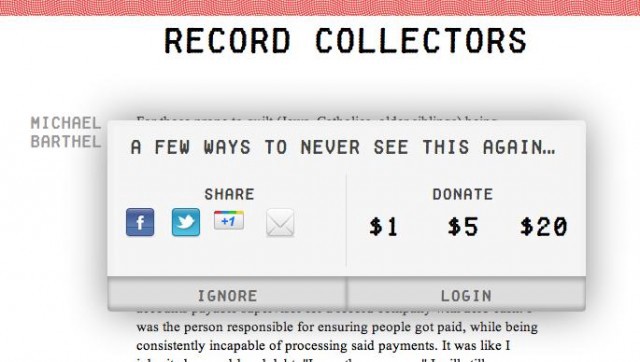
Over the weekend, a group of loony volunteers and writers put out the third issue of Longshot magazine, which is a very attractive product in print particularly and you may buy that right here. (The huge vault of radio programming is also incredible if you like listening to things!) The shtick is that it’s all written and built and published in 48 hours.
But that’s not the most interesting thing about it, if you care about the digital age. So here we are in this wacky new time, after the New York Times debuted their intentionally porous metered paywall, after the Financial Times’ strict subscriber-only paywall, and all the versions in-between, from half-subscriber-only to complete lockdown, and it’s a great question about what to do that’s right. The Longshot web team (led by Adam Hemphill) came up with a fascinating iteration. Their nagwall appears after a good amount of browsing — you can read quite a bit without being harassed. And then it asks you to consider giving one of two different kinds of currency: it wants you to share the site with a friend or to straight-up give money. Equal value!
It also gives you something most paywalls don’t have: a big option to “ignore.” It’ll crop up again, eventually.
And they also built something wonderful, which looks like they’ve commented-out in the code right now, so it’s not happening (you try building an actual magazine website from scratch in 48 hours), but they built it so that, if users clicked through to give money via Paypal, and then didn’t actually follow-through, a friendly message would acknowledge that choice.
The thinking behind this idea seems really sound to me! It’s a direct ask for something people can give. It’s definitely not a demand. It’s good-humored. And it’s a relatively simple interface. I’d love to see what people build on from there.
(And of course, there are things to read on this website. If I had to play favorites in the magazine, it’d be this account of a bill collectors’ fake courtroom. Though there’s a wonderful Paul Ford piece and this story by Mike Barthel about being an accounts payable manager is great, and I loved this piece on our aging water contracts in the West and, OH, here is one really remarkable thing, a small collection of emails received by a “small independent magazine” about paying writers. But, of course, print is a different experience — for instance, there’s a hilarious Dan Kois thing that is magazine-only!)
German Tourists Try To Get Over
Make of this what you will: “German tourists tend to use precious vacation time hunting for flaws in their vacation packages or accomodations. With the right evidence, they hope to score a discount or reimbursement…. ‘ The Germans are behind a disproportionately high number of the ridiculous complaints.’”
There Are Plenty Of Reasons To Drink

You will not find this surprising: “People find that drinking wine helps them to relax more than spending time with their children or partner, according to a survey. Nearly two thirds (61 per cent) of adults said drinking was their top choice after a stressful day, while just over a quarter (28 per cent) said spending time with their children helped them relax and 26 per cent opted for talking with their partner.”
There is, however, something alarming that this research has discovered: “Among both sexes, nearly two-thirds admit to drinking after a stressful experience and 73 per cent after a bad day at work. This compares with just 15 per cent who drink after a great day and 17 per cent who hit the bottle after a ‘good day’ at work.”
See this, to me, is where alcohol’s amazing ability to make the awful realities of existence tolerable does itself a disservice, in the sense that people quite rightly focus on how alcohol allows you to make it through another terrible day, but ignore the way that alcohol can also enhance those all-too-rare high points in life. What those 15% of people who drink after a great day know that the rest of you don’t is that it isn’t officially a “great” day until you’ve added alcohol to it. I guess what I’m saying is you should be drinking in both good times and bad, because alcohol is just that versatile. Enjoy!
A Completely Sane Visual Guide To The Debt Ceiling Crisis
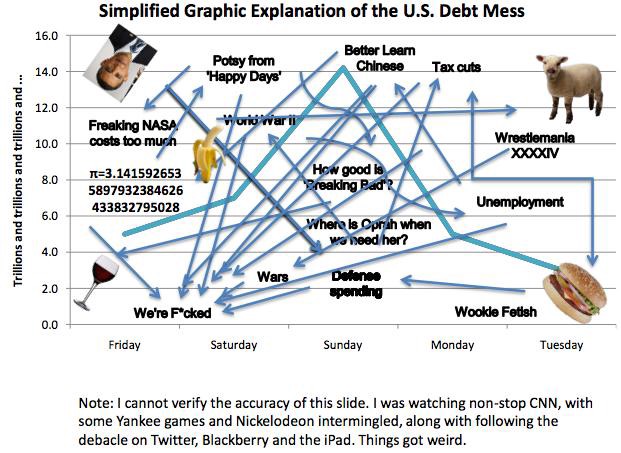
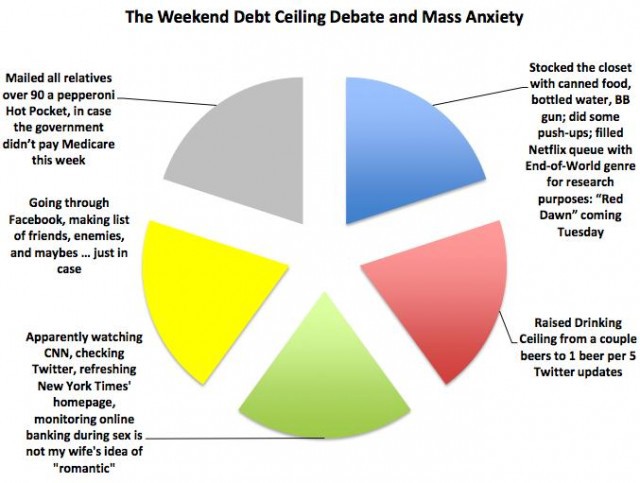
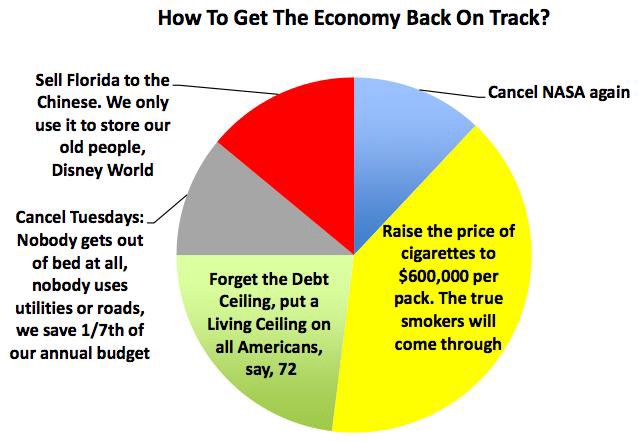
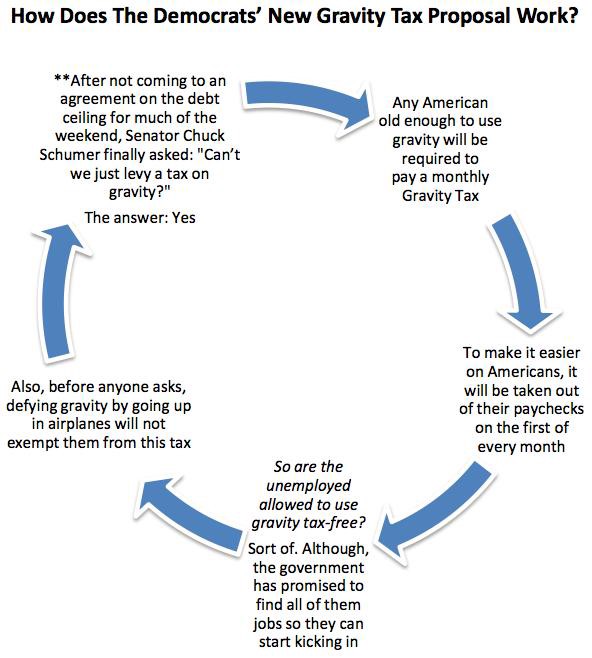
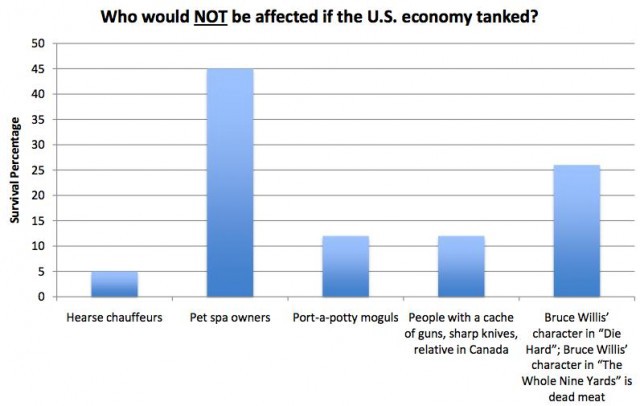
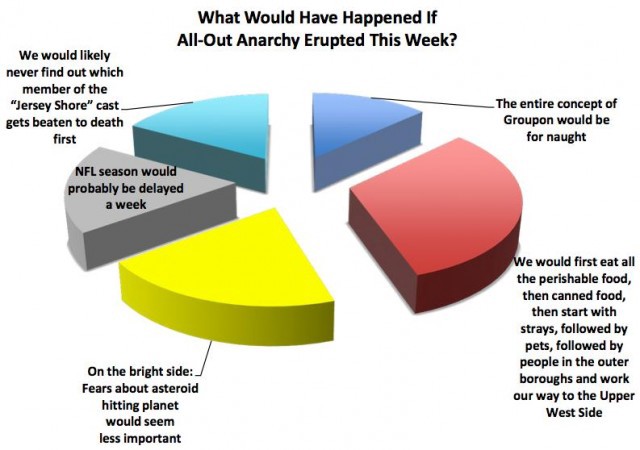
Jon Methven is the author of This Is Your Captain Speaking, due out in 2012 by Simon & Schuster. He can be reached here, or follow him on Twitter @jonmethven.
Shopping for Men: The New Yorker's Complete (and Catty) Guide
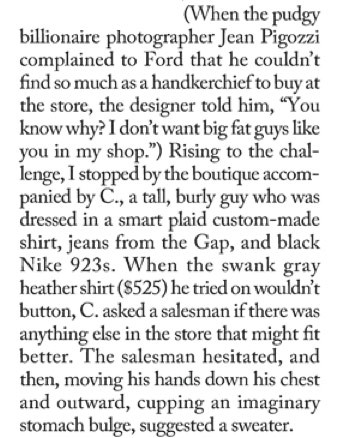
Today, Patricia Marx goes shopping with men in the New Yorker! (Yes, subscription-only, so, sadtrombone.wav.) The whole thing is a really quite largely useful guide for men who are baffled and scared, from Brooks Brothers to Bergdorf Mens’ Store to 20 Peacocks (although just don’t even go in that Ralph Lauren store, gross), and you should note that Ms. Marx’s male friend really ought to have bought the blue Zegna suit at Bergdorfs, it’s gorgeous. But here is the most relevant passage to our interests. The Tom Ford store on Madison Ave. is America’s greatest shopping treature! I bet it was that haughty Russian shopboy Nikolai! No, but seriously: if you can’t fit into his fascist shirts, you’re definitely not going to fit into the fall sweaters. Get a nice tie.
Extreme Buttwashing Does Nothing
As it turns out, firehosing a ton of water up your butt may not be good for you.
"Mrs. Strauss-Kahn": The Heiress Who Married "Some Sort of Cretin"

“Even Kirstie Alley, who is living in an apartment next door, makes an appearance. She crawls on to her fire escape with a cigarette, making sure that the paparazzi below get a shot of her book, The Best Little Whorehouse in Texas. An African-American pap takes a few pictures, because there’s nothing else going on, but then she starts yelling about her privacy being invaded, except she yells at the wrong black pap. ‘The other black guy is darker than me, and bald, and shorter, Ms. Alley,’ shouts the other pap. ‘I’m not the same black guy.’ He shakes his head. ‘But we all look alike, right?’”
— Vanessa Grigoriadis! The only writer I would possibly read on the story of Dominique Strauss-Kahn and his wife is, fortunately, the one who wrote this story!
Man Could Hear His Own Eyes Roll In Their Sockets
Can you imagine anything more creepy than being able to hear your own eyes roll? Even a simple act such as reading the New York Times op-ed page would be a horrifying experience.
John Boehner's PowerPoint
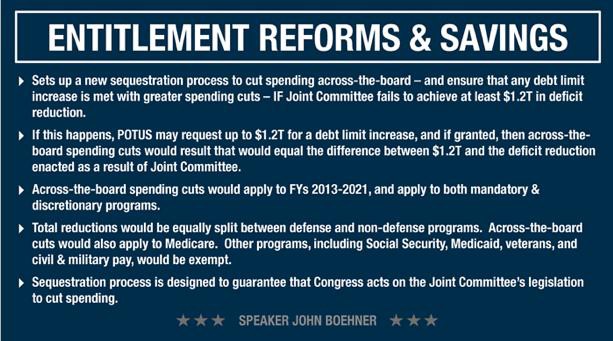
From the Times comes John Boehner’s PowerPoint presentation on the “debt ceiling deal,” which deserves so many scare quotes than that. Despite it being a complex arrangement described in bulletpoints — which, plenty of room to obscure things there! — it’s also a useful and frightening document. It’s also really the only thing to read today. The newspapers are otherwise only carrying process and “perception” stories about politics — apart from this smart move by the Times, there’s very few ways to actually figure out what the alleged “deal” is. But spoiler: the “debt ceiling crisis” is actually just the first of a series of crises. We can now look forward to the “balanced budget amendment crisis” and the “committee to reduce the deficit crises,” circa Thanksgiving.
